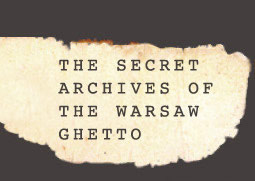The Warsaw Ghetto
Emmanuel Ringelblum, historian
The Oyneg Shabbes collective
Alerting the world
The Preservation of the Archives
Rediscovery
The Oyneg Shabbes collective
Emmanuel Ringelblum was helped in his work by the economist Hersz Wasser and the teacher Eliahu Gutkowski. Other intellectuals joined in,
among whom Rabbi Shimon Huberband, the young economist Menahem Linder, Professor Israel Lichtensztajn, who directed respectively the religious,
economic and statistical, and the educational sections of the Jewish Mutual Aid. Other occasional helpers made contributions: historians, writers,
economists, doctors, scientists, social workers, etc. and other informers brought intelligence and news from regional ghettos.
These were often women whose ‘Aryan physique’ facilitated such dangerous missions. Some of these individuals, such as the doctor and teacher
Janusz Korczak or the author Jehoshua Perle, were already well known in Poland before the war, but others remained anonymous. Most of them died in the
Warsaw Ghetto or in the Treblinka extermination camp in 1942 and 1943.
Little by little and in complete secrecy, a vast documentation on the situation in Warsaw and in other Polish ghettos was accumulated. Accounts,
detailed reports, involving every aspect and event in the lives of the Jews, particularly all that concerned underground activity, were collected.
Lists of deportees and forced laborers were established as well as testimonials from the various Polish ghettos. A significant collection of official
documents was amassed which gave substance to the continual aggravation of persecution: pronouncements by the occupation authorities, official forms,
food rationing cards, identity papers, billeting documents and certificates of employment, altogether a vast variety of printed matter, down to the
wrapping used for products manufactured in the ghetto. In addition to a compilation of the Jewish underground press, Oyneg Shabbes ensured the
conservation of literary works as evidence of the intense intellectual and cultural activity within the ghetto.
Emmanuel Ringelblum and his friends planned to lay down the foundations of a scientific institution. They hoped to publish a momentous collective
work entitled "Two and a Half Years of War" which was to be a vast encyclopedia of life and death in the ghetto under Nazi rule. The enterprise
was thwarted by the launch of ‘Aktion’: the arrest and deportation to the Treblinka extermination camp of almost four-fifths
of the Warsaw Ghetto's inhabitants, between July 22 and September 21, 1942

© Jewish Historical Institute, Warsaw






